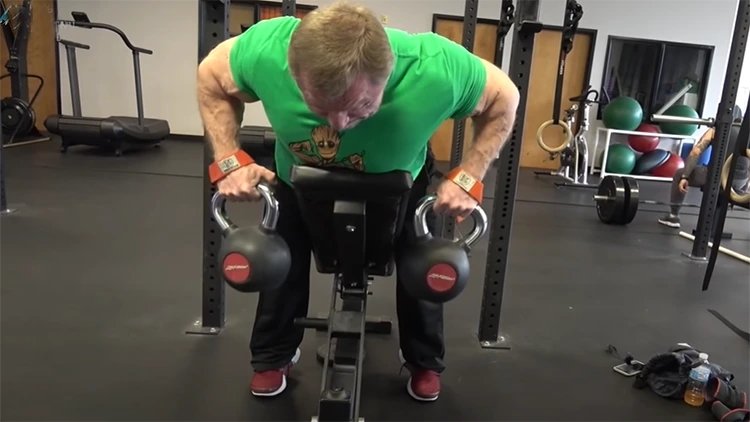
The humble row is a horizontal pulling exercise that’s similar to the chest supported row that uses dumbbells, but the difference in elbow positioning makes it more effective in targeting the upper back.1
While this is one reason it’s ranked the top chest supported row exercise, the true reason is because a recent study found that exercises with a lower stimulus to fatigue ratio (SFR) don’t produce as much raw stimulus magnitude in the muscle (RSM), but when programmed correctly they can actually result in more muscle growth.
In simple terms, this means the best exercises are ones that produce a lot of muscle activation, without causing too much fatigue on the joints and CNS (central nervous system) which allows for more reps, more sets, and quicker recovery than exercises that are more fatiguing.
Below we’ll explain this even further and cover everything you need to know about the humble dumbbell row such as:
- The differences between chest supported db rows vs humble db rows
- How to perform the humble dumbbell row with perfect form
- Common mistakes and tips to fix them
- Muscled worked during the humble dumbbell row
- The benefits of humble dumbbell rows
- Humble dumbbell row alternatives
- A workout program that incorporates humble dumbbell rows
So before adding the humble dumbbell row to your gym routine, learn about the ins and outs of this row variation to decide if it’s a good fit for you.
What Is the Humble Row Exercise?
The humble dumbbell row is a variation of chest supported row that looks similar to some of the more well-known variations, but with a few important differences that make it even more effective.
It’s hard to trace back exactly where the humble db row originated, but it has become a staple in niche groups for its effectiveness in building upper and middle back muscles.
Funny enough, the humble db row is said to have earned its name because it humbles the amount of weight a person can do with it, for two reasons:
- It’s a challenging exercise that causes an intense burn in muscles that most lifters don’t hit regularly.
- To do it right, it has to be done with a low-moderate weight, effectively stopping ego lifters in their tracks.
The Difference Between Humble vs Chest Supported Dumbbell Rows (Incline Row)
At first glance, the humble db row and the Incline db row (a more common variation of chest supported rows) look identical, but they differ in two ways. First, the incline db row and the humble db row target similar muscles, but the humble dumbbell row is much better at hitting the upper and middle back.
The second difference is the hand and elbow position that affects which muscles are worked.
With the Incline Row, the hands are in a neutral position, and the elbows come down and back in a sweeping motion, targeting the lats.
With the Humble dumbbell row, the hands are in an overhand (pronated) grip, and the elbows come out at a 45 – 90 degree angle, targeting the upper and middle back muscles.
Why Are Humble Dumbbell Rows the Top Chest Supported Row Exercise?
To understand what makes the humble dumbbell row such an effective movement, let’s revisit the SFR and RSM principles mentioned earlier.

Source: Gorilla Freak via Canva.com2
RSM, or the raw amount of muscle stimulus produced, is necessary to build muscle. This is the overall amount of stress put on the muscle that induces it to grow in the first place.
However, not all stress is equal, and the best exercises give the maximum amount of muscle stimulation while reducing fatigue and strain on the body. That’s where SFR comes in.
SFR (stimulus to fatigue ratio) is the most important factor in muscle growth. It is the ratio of how much a muscle is worked compared to the amount of strain it places on the body. Ideally, an exercise should have very high stimulus and low fatigue.
And while other row variations have high stimulus, they are more exhausting on the body, the mind, and the joints. This is what makes the humble dumbbell row so powerful.
Since a light to moderate weight has to be used to perform the humble dumbbell row correctly, overall fatigue is reduced, but in this case lowering the weight doesn’t decrease the exercise’s muscle building effect.
The combination of low fatigue and high stimulus makes it the ideal chest supported row, and since most people have never even tried this exercise before, they might see an increase in growth just from hitting the muscle in a new way.3
How To Perform Humble Dumbbell Rows With Perfect Technique
To get the max benefit from any exercise, it’s important to get the form right. These are the five easy steps to perfect form on the humble dumbbell row.
1. Set up a bench at a 30-45 degree angle, ensuring it’s properly locked and stable.
2. With the chest resting on the bench, grab the dumbbells with an overhand grip. The arms should be fully hanging, with the shoulder blades protracted.
*Pro Tip: Using a towel or rolled-up shirt helps relieve the pressure from leaning the chest against the bench.*
3. Tighten the core, and retract the shoulder blades (bring them together) while bringing the elbows up and out.
4. Pause briefly at the top, focusing on the contraction in the upper back/traps and the middle back.
5. Slowly lower the weight back to the starting position, relaxing the shoulder blades and preparing for the next rep.
Humble Dumbbell Row Form Tips
Bodybuilders swear by visualization and mental cues to take their gains to the next level.
When they can see the exercise in their mind, they maximize the mind muscle connection. Professional bodybuilders emphasize that visualization and a strong mental game are crucial in manifesting your dream body, making it a serious consideration.
These two mental form cues will have anyone performing the humble dumbbell row like a master in no time.
Elbows out: If the goal is to maximize muscle growth, getting a full range of motion is non-negotiable.4 So when doing the humble dumbbell row, think about pulling the elbows straight out and up, almost at a 90 degree angle.
A good visual cue is to imagine an invisible bar connecting the dumbbells. The invisible bar should rise straight up to the center of the chest, resembling a reverse bench press.
Squeeze The Shoulder Blades: For the best muscle activation, the shoulder blades have to be squeezed together at the top of the rep and fully extended at the bottom.
Squeezing the shoulder blades is also known as scapular retraction, and using it properly is the difference that allows the trapezius and rear delt muscles to be targeted instead of the lats.
Common Mistakes When Doing the Humble Dumbbell Row
Because the humble row looks so similar to other row variations, it’s easy to make mistakes, and avoiding these two common mistakes is essential to get the maximum benefit from the exercise.
Going Too Heavy: The humble dumbbell row requires finesse, not power. Going too heavy puts the shoulders at risk and without any increase in muscle activation.
Slow, quality reps with a light to moderate weight will help prevent injury and ensure that the muscles are fully activated.
There’s no shame in lowering the weight, and ego lifting is one of the most harmful mistakes lifters make.(It just narrowly avoided making the list of 8 deadly training sins.)
Letting the Lats Take Over: Because the lats are such a large muscle group, they tend to take over when it comes to rowing movements, overpowering the smaller muscle groups of the movement. Remembering to drive the elbows out keeps the focus on the upper back and reduces engagement in the lats.
Humble Rows Muscles Worked
The humble dumbbell row hits muscles in the back that most athletes struggle to develop and that, when built properly, make the physique look healthier, stronger, and more aesthetic. These are the key muscle groups worked:
Posterior Deltoids (Rear Delts)
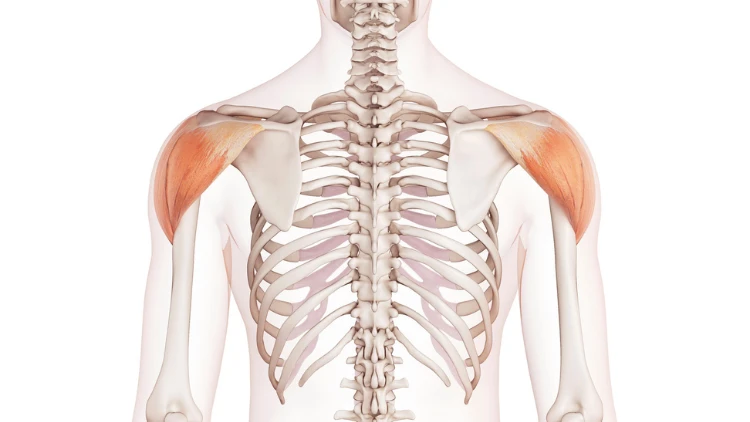
Source: Science Photo Library via Canva.com5
The rear delts often go overlooked in many athletes’ physiques, with some even regarding them as the hardest muscle to develop. So adding in the humble dumbbell row is a perfect way to activate and develop size in this difficult to hit area, giving the shoulders that much sought-after “capped” look.
By making sure the elbows are coming out and up, and pausing at the top, the exercise will provide max stimulus for the rear delts.
Pro Tip: If there’s a struggle to grow the rear delts, research shows that trouble muscles grow best when worked earlier in the workout, so hit the rear delts first!6
Trapezius (Traps)
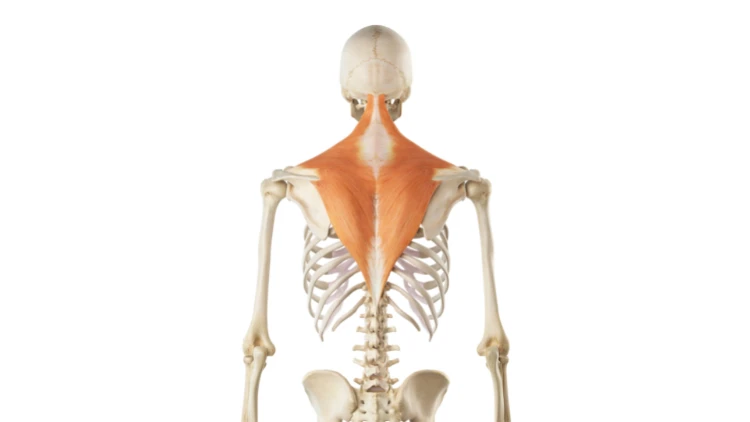
Source: Science Photo Library via Canva.com7
If there’s a muscle that boasts “Power” and strength, it’s the trapezius.
Well-developed traps make the upper back and neck appear thicker and offer vital support to the shoulders.
At the beginning of the humble dumbbell row, stretch the traps by protracting the shoulder blades, and follow it up with a strong contraction at the top of the rep to engage the muscle fully.
Rhomboids
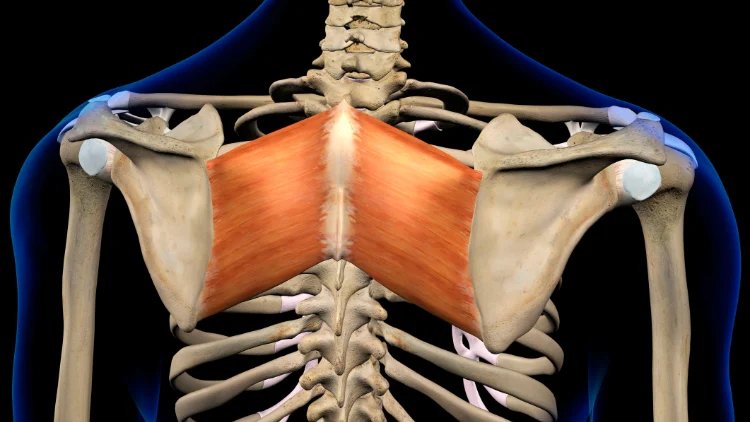
Source: Hank Grebe via Canva.com8
Like the trapezius muscles, the rhomboids play a key role in shoulder health and stability, except even more so. This small muscle group is worked in the humble dumbbell row through the scapular retraction and protraction mentioned above.
Latissimus Dorsi (Lats)
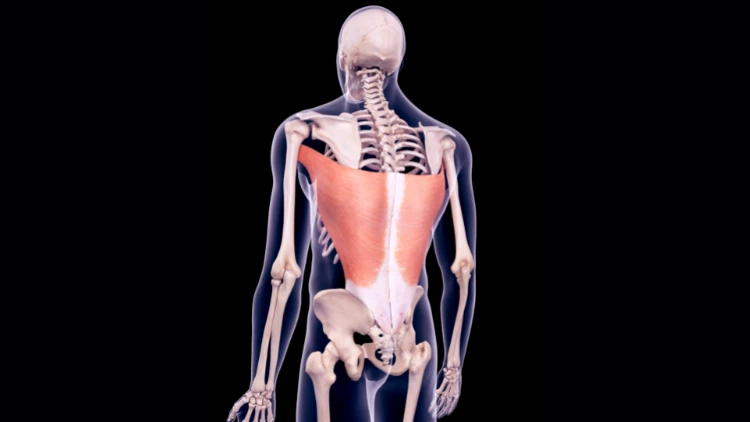
Source: Science Photo Library via Canva.com9
While the lats aren’t the primary focus of the movement, they still get some muscle activation, but it should be kept to a minimum to avoid them taking away from the rest of the back.
Other movements mentioned later in the article will target the lats more directly, and allow for heavier weights to be lifted safely.
Biceps Brachii (Biceps)
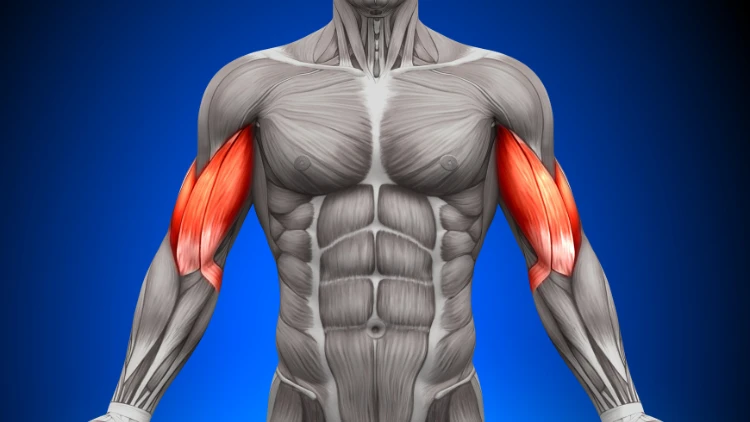
Source: decade3d via Canva.com10
The biceps (besides being fun to flex) are important for the wrist’s rotation and elbow flexion. The biceps will get some assistance work through the humble dumbbell row, but they aren’t the movement’s primary focus.
Chest Supported vs. Humble Dumbbell Rows: Muscles Worked
In other variations of chest supported rows, the same muscle groups are worked:
- Trapezius
- Lats
- Rear Delts
- Rhomboids
- Biceps
The key difference is that with other row variations, there will be much more stimulus in the lats and the biceps. It’s also more common to load other rows with a lot of weight, which at times can be beneficial but can also take away from the overall muscle activation of the movement if form is compromised.
Benefits of Humble Dumbbell Row Over Other Chest Supported Rows
The benefits of the humble db row differ from the other types of chest supported db rows, and this exercise is effective because of the following reasons:
First, as stated earlier, the humble db row “humbles” how much weight can be used. To perform the exercise correctly, the lifter has to use a lighter weight, which increases muscle activation and reduces the risk of injury.
This means that overloading the movement with too much weight isn’t just impractical but almost impossible.
Second, humble dumbbell rows target the upper and middle back, which is a tricky area to develop for many athletes. It’s a hard to develop area because in most row variations, the lats take over the movement, and the back is tired before those smaller areas get any stimulus.
So while the incline dumbbell row muscles worked are primarily the lats and biceps, with the humble dumbbell row, the alignment of the elbows takes the lats out of the movement and allows the rear delts, traps, and rhomboids to get more direct stimulation than any other row variation.
Third and most important is the fact that the humble dumbbell row offers a high amount of muscle stimulation with very low fatigue. The best exercises for muscle growth are going to provide a ton of stimulation for the muscle (RSM), but minimal fatigue.
As mentioned earlier, the key concepts to keep in mind in any training program are SFR and RSM, and the humble dumbbell row excels at these.
There aren’t many exercises that, even without heavy weight, will give the kind of burn and pump that the humble dumbbell row does, while putting almost no strain on the joints. For this reason alone, the humble dumbbell row is superior.
Alternatives & Variations To Humble Rows
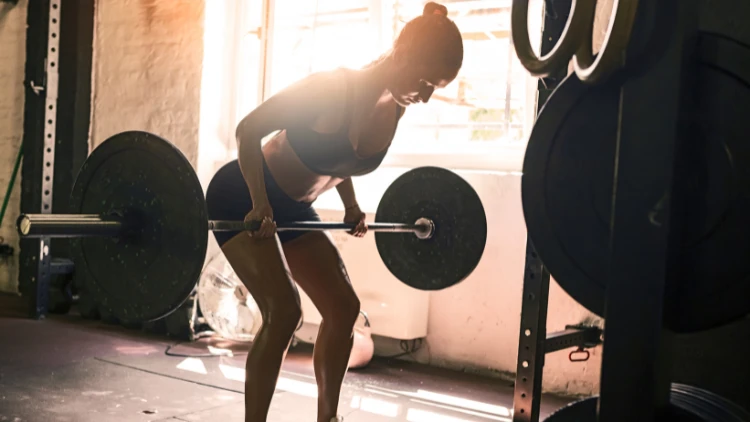
Source: Nastasic via Canva.com11
The humble row is a great exercise but it can’t build the back alone! These exercises will benefit anyone aiming to get stronger and build a more powerful and aesthetic physique.
Barbell Bent-Over Row
The barbell bent-over row is one of the most common row variations, and this row is great because the user can pull very heavy weight, building muscle and power throughout the back. If the focus is on building overall size in the lats, this exercise is a must have
Cambered Bar Row
The cambered bar row is similar to a standard bent-over barbell row, however, this exercise is performed with the cambered bar instead of a straight bar. The bend in the cambered bar allows the weight to be pulled to the body and past the body, giving a much deeper stretch and contraction than the standard barbell row.
Pull-Ups
Any athlete that can do pull-ups should do them regularly, and anyone who can’t currently do a pull-up should be building up to doing them.
The pull-up is a powerhouse at developing the back, and bodybuilders have referred to the weighted pull-up as the “squat of the upper body”. It’s hard to find any other exercise that carries that kind of reputation.
Pro Tip: Try switching up between overhand, neutral, and underhand grip on the pull-ups, as varying the grip has been shown to increase muscle growth.12
Lat Pulldowns
The lat pulldown is a close second for anyone who can’t do a pull-up yet or wants some variety in their routine. Lat pulldowns, like pull-ups, work the entire back but focus mainly on the lats, widening the back and giving a nice v-taper look.
Incline Dumbbell Row
The incline dumbbell row looks so similar to the humble dumbbell row it could be mistaken for the same movement. But as explained earlier, this variation involves pulling the elbows back, with the hands in a neutral or underhand position, and gives more focus to the lats.
The incline row is also referred to as the “inverted row dumbbell variation”, but it’s the same exercise.
One-Arm Dumbbell Row
The one-arm dumbbell row is another common row variation, and because it’s a unilateral movement, actually allows more weight to be lifted than in a standard barbell row.13
Like with the humble dumbbell row, form is key. Pulling the elbow up for a full contraction and then getting a good stretch in the lat at the bottom of the movement will produce much more muscle stimulus than just jerking around the heaviest weight possible with poor form.
T-Bar Row & Chest Supported T-Bar Row
Most gyms will have either a regular t-bar, or a chest supported t-bar, but some gyms might have both. The T-Bar row is a horizontal movement that looks similar to the bent-over barbell row and primarily targets the lats.
The chest-supported T-bar row is almost identical. The difference is that having the chest supported makes it a more stable movement and more like an isolation exercise than the regular T-Bar row.
Seal Rows
The final exercise on the list is the Seal Row (another popular variation of dumbbell lat exercises is the incline DB seal row). This exercise is called a seal row because..
Well because it makes the lifter look like a seal! It’s performed lying facedown on a bench, with the legs and hips relaxed, using only the arms to do the exercise.
While this exercise does work similar muscles to the humble dumbbell row, the main problem is finding a bench high enough to do it on. Most people resort to propping a bench up on top of a bunch of weight plates to get a full range of motion, but this is only sometimes practical and probably not very safe.
Workout Program That Incorporates Humble Rows
This pull-day routine incorporates the humble dumbbell row while hitting the back from every angle and will seriously improve the thickness and strength of the back.
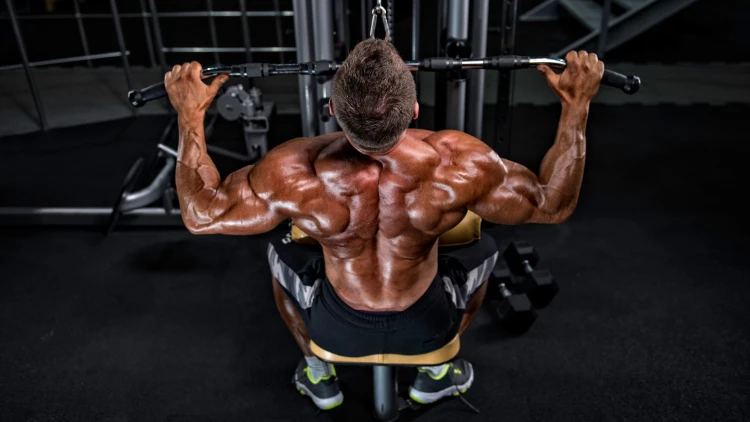
Source: MRBIG_PHOTOGRAPHY via Canva.com14
Intermediate to advanced lifters will find this workout beneficial, but beginners should first review the beginner guide to ensure they understand form, nutrition, and programming before incorporating it as an accessory into the beginner hypertrophy program.
- Wide Grip Lat Pull-downs: 3 sets of 8-12 reps.
- Bent over Barbell Row: 3 sets of 8-12 reps
- Humble Dumbbell Row: 3 sets of 12-15 reps (Focus on contraction and controlling the movement!)
- Dumbbell Curls: 3 sets of 8-12 reps
- Face Pulls: 3 sets of 12-15 reps
- Lower Back Extension: 3 sets of 10-15 reps (Start unweighted and slowly build up to avoid injuring the lower back)
There really is no chest supported row that can match the humble dumbbell row. The exercises’ ability to target the hard-to-hit muscles of the middle and upper back, while producing almost no fatigue, makes the humble row a necessary addition to any back training routine.
Frequently Asked Questions
How Does the Row Angle Affect Muscles Worked?
The higher the angle of the bench, the more the exercise targets the upper back and shoulder muscles. The lower the bench, the more the focus is on the lats. But setting the bench in the 30-45 degree range is perfect for the humble row.
Which Is Better: Pronated Chest Supported Row vs. Neutral vs. Supinated?
It depends on the goal.
A neutral grip primarily targets the lats, while a supinated (underhand) grip targets the lats and the biceps. A pronated (overhand) row will target the upper back, traps, and rear delts much more than the other two grip variations.
Which grip is used and when should be based on the lifter’s overall goal and what provides the most stimulation in the target muscle group.
References
1“Exercise Index | Incline Dumbbell Rows.” YouTube, 11 January 2019. Accessed 15 April 2023. <https://www.youtube.com/watch?v=BzPuC0X69Kg>
2Gorilla Freak. “topless man wearing black and white cap photo – Free Brown Image on Unsplash.” Unsplash, 21 October 2020. Accessed 12 April 2023. <https://unsplash.com/photos/wt5jg8_WrJg>
3Costa, B. D. V., Kassiano, W., Nunes, J. P., Kunevaliki, G., Castro-E-Souza, P., Rodacki, A., Cyrino, L. T., Cyrino, E. S., & Fortes, L. S. (2021). Does Performing Different Resistance Exercises for the Same Muscle Group Induce Non-homogeneous Hypertrophy?. International journal of sports medicine, 42(9), 803–811. <https://pubmed.ncbi.nlm.nih.gov/33440446/>
4Pinto, R. S., Gomes, N., Radaelli, R., Botton, C. E., Brown, L. E., & Bottaro, M. (2012). Effect of range of motion on muscle strength and thickness. Journal of strength and conditioning research, 26(8), 2140–2145. <https://pubmed.ncbi.nlm.nih.gov/22027847/>
5Science Photo Library. “”Human shoulder muscles.” Canva. Accessed 12 April 2023. <https://www.canva.com/photos/MADmTOcznCU--human-shoulder-muscles/>
6Jakobi, J. M., & Chilibeck, P. D. (2001). Bilateral and unilateral contractions: possible differences in maximal voluntary force. Canadian journal of applied physiology = Revue canadienne de physiologie appliquee, 26(1), 12–33. <https://pubmed.ncbi.nlm.nih.gov/20938358/>
7Science Photo Library. “”Human trapezius muscles.” Canva. Accessed 12 April 2023. <https://www.canva.com/photos/MADmTLHptgU--human-trapezius-muscles/>
8Hank Grebe. “Male Rhomboid Major Back Muscles in Isolation on Skeleton.” Canva. Accessed 12 April 2023. <https://www.canva.com/photos/MAD9YMm5tt4-male-rhomboid-major-back-muscles-in-isolation-on-skeleton/>
9Science Photo Library. “F017/1255.” Canva. Accessed 12 April 2023. <https://www.canva.com/photos/MADq3vbyn-k-f017-1255/>
10decade3d. “Biceps – Anatomy Muscles.” Canva. Accessed 12 April 2023. <https://www.canva.com/photos/MAC_wOJW8Sk-biceps-anatomy-muscles/>
11Nastasic. “Young woman lifting weights.” Canva. Accessed 12 April 2023. <https://www.canva.com/photos/MAEJA8l0euk-young-woman-lifting-weights/>
12Dickie, J. A., Faulkner, J. A., Barnes, M. J., & Lark, S. D. (2017). Electromyographic analysis of muscle activation during pull-up variations. Journal of electromyography and kinesiology : official journal of the International Society of Electrophysiological Kinesiology, 32, 30–36. <https://pubmed.ncbi.nlm.nih.gov/28011412/>
13Spineti, J., de Salles, B. F., Rhea, M. R., Lavigne, D., Matta, T., Miranda, F., Fernandes, L., & Simão, R. (2010). Influence of exercise order on maximum strength and muscle volume in nonlinear periodized resistance training. Journal of strength and conditioning research, 24(11), 2962–2969. <https://pubmed.ncbi.nlm.nih.gov/11173667/>
14MRBIG_PHOTOGRAPHY. “Body Building Workout.” Canva. Accessed 12 April 2023. <https://www.canva.com/photos/MAEEP20kXn4-body-building-workout/>